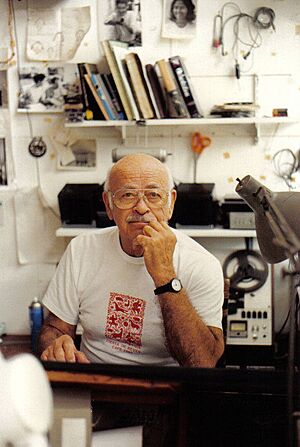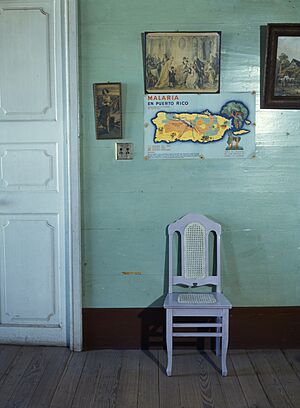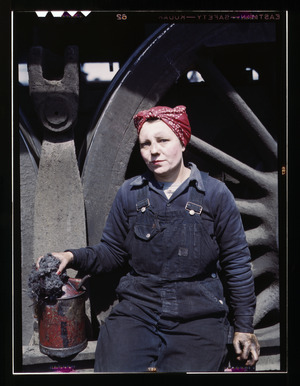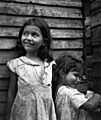Jack Delano facts for kids
Quick facts for kids
Jack Delano
|
|
|---|---|

Jack Delano in his studio. Trujillo Alto, Puerto Rico, 1990
|
|
| Born |
Jacob Ovcharov
August 1, 1914 Voroshylivka, Russian Empire (now Ukraine)
|
| Died | August 12, 1997 (aged 83) |
| Nationality | American |
| Occupation | photographer for the Farm Security Administration |
Jack Delano (born Jacob Ovcharov; August 1, 1914 – August 12, 1997) was an amazing artist who did many things. He was a photographer, a composer, a moviemaker, and even a cartoonist! He was born in Ukraine and later moved to the United States.
Jack Delano is best known for his powerful photographs. He worked for important government groups like the Farm Security Administration (FSA). His photos showed what life was like for people during tough times in America. Later, he moved to Puerto Rico and became a beloved artist there.
Contents
Early Life and Education
Jack Delano was born Jacob Ovcharov in a small town in Ukraine in 1914. His family was Jewish. When he was nine years old, in 1923, his family moved to the United States. They sailed on a ship called the SS Homeric and settled in Philadelphia, Pennsylvania.
From 1924 to 1932, Jack studied art and music. He learned about graphic arts and photography. He also played the viola and learned how to compose music. He attended the Settlement Music School on a scholarship.
After high school, he went to the Pennsylvania Academy of the Fine Arts (PAFA). There, he continued to study art and music. He won a special scholarship called the Cresson Traveling Scholarship. This allowed him to travel to Europe. While there, he bought his first camera, which sparked his interest in photography.
Career Highlights
Photography for the Farm Security Administration
After art school, Jack Delano found it hard to get a job in painting or music. He heard about a photography program with the Federal Art Project. He moved to New York and started taking photos on his own.
He proposed a project to photograph coal miners in Pennsylvania. He sent his sample pictures to Roy Stryker, who led the Farm Security Administration (FSA) Photography Program. With help from other photographers, Jack got a job at the FSA in 1940.
The FSA was a government program created during the New Deal. This was a time when President Franklin D. Roosevelt was trying to help Americans recover from the Great Depression. The FSA helped small farmers and struggling communities.
Many famous photographers worked for the FSA. Jack Delano's work was special because he focused on cultural and social patterns. He didn't just photograph people and landscapes. He explored how people lived and worked in different regions.
Documenting World War II
When the United States joined World War II, Jack Delano photographed American industries. He showed how factories were preparing for the war. In 1943, he joined the United States Army Air Corps. He served in the South Pacific until 1946.
During his time in the military, he kept filming and photographing. He documented his experiences as a soldier. Much of his work from this time is still kept secret today. He returned home as a captain. He was determined to move to Puerto Rico with his wife, Irene. They had both fallen in love with the island.
Life in Puerto Rico

Jack Delano first visited Puerto Rico in 1941 for the FSA project. He was supposed to stay only a few days. But his trip lasted months because of the Attack on Pearl Harbor. This event led the U.S. to declare war.
This trip changed his life. He was amazed and also saddened by what he saw. He had never seen such deep poverty, but he also met incredibly kind people. In 1946, he moved to Puerto Rico permanently.
He became very famous and loved on the island. Almost everyone in Puerto Rico knew his work. He created illustrations, cartoons, movies, and even musicals.
Jack and his wife, Irene, worked for the Department of Public Education. They made films to help educate people. Jack often composed the music for these films. He also directed a classic Puerto Rican film called Los Peloteros. It's about poor kids who love baseball.
Delano's Unique Photography Style
Jack Delano's photographs were highly respected. He often chose unusual subjects and locations. He also used unique ways of showing size and distance in his photos. This made his pictures stand out from other FSA photographers.
He used these techniques to make his subjects seem more important. He wanted to show the strength and character of everyday people. He often photographed the difficult or unsafe conditions people lived and worked in. His photos highlighted the importance of the "average" person. They also showed the tough conditions in coal mines and Puerto Rico.
Musical Works and Public Television
Jack Delano was also a talented composer. He wrote music for orchestras, ballets, and choirs. Many of his pieces were for the Puerto Rico Symphony Orchestra. He often used Puerto Rican folk music in his classical compositions.
He also worked on children's books with his wife and friend Tomás Blanco. One famous book is The Child's Gift: A Twelfth Night Tale. Jack even wrote music in the margins of the book!
In 1957, Jack and his friends helped start Puerto Rico's first public educational television station, WIPR. The goal was to use films and graphics to improve education in rural areas. Jack worked there as a producer, composer, and program director. This led him to focus more on creating in other areas besides photography.
WIPR produced many important programs. One show in 1961, "Puerto Rico: Workshop for the Americas," highlighted Puerto Rico's growth. It even featured an interview with the governor, Luis Muñoz Marín.
Death
Jack Delano passed away in San Juan, Puerto Rico, on August 12, 1997. He was 83 years old. His art and music left a lasting impact on both the United States and Puerto Rico.
Gallery
-
"Washing eggs to be sold at Tri-County Farmers Co-op Market at Du Bois, Pennsylvania", August 1940
-
"Children in Utuado, Puerto Rico", May 1942
-
One of Delano's most famous pictures, of Chicago Union Station, January 1943
-
Roundhouse wipers at lunch, Clinton, Iowa, April 1943
-
Women wipers of the Chicago and North Western Railroad cleaning one of the giant 4-8-4 "Northern" H-class steam locomotives, Clinton, Iowa, April 1943
-
Newsboy selling Chicago Defender, 1942
-
C. & N.W. R.R., Mrs. Marcella Hart, mother of three children, employed as a wiper at the roundhouse, Clinton, Iowa. April 1943.
-
"FSA borrower who lives in village La Vallee, St. Croix island, Virgin Islands." Dec 1941.
-
"Loading oranges into refrigerator car at a co-op orange packing plant," March 1943.
-
Sugar cane workers resting
-
Spreading asbestos mixture on boiler of a locomotive at the C & NW RR [i.e. Chicago and North Western railroad], 40th Street locomotive shops. Dec 1942.
-
"Sugar cane workers resting at the noon hour," Rio Piedras, Puerto Rico. 1941.
-
"Street scene, Christiansted," St. Croix, Virgin Islands. 1941.
-
"Chicago and North Western railroad," William London has been a railroad worker 25 years - now working at the roundhouse at the Proviso yards. 1942.
-
"Sugar cane worker and his woman", Rio Piedras, Puerto Rico. 1941.
-
"Chopping cotton on rented land near White Plains," Greene County, GA. June 1941.
-
Atchison, Topeka, and Santa Fe railroad conductor George E. Burton and engineer J.W. Edwards comparing time before pulling out of Corwith railroad yard for Chillicothe, Illinois; Chicago. March 1943.
-
Melrose Park (near Chicago), Ill.; C & NW RR [i.e. Chicago and North Western railroad]; Roy Nelin, a box packer in the roundhouse at the Proviso yard. Dec 1942.





























